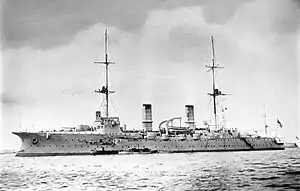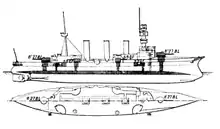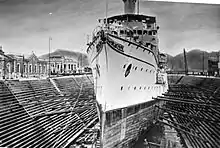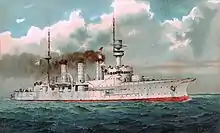SMS Hansa (1898)
SMS Hansa was a protected cruiser of the Victoria Louise class, built for the German Imperial Navy (Kaiserliche Marine) in the 1890s, along with her sister ships Victoria Louise, Hertha, Vineta, and Freya. Hansa was laid down at the AG Vulcan shipyard in Stettin in 1896, launched in March 1898, and commissioned into the Navy in April 1899. The ship was armed with a battery of two 21 cm guns and eight 15 cm guns and had a top speed of 19 knots (35 km/h; 22 mph).
 SMS Hansa | |
| History | |
|---|---|
| Name: | SMS Hansa |
| Namesake: | Hanseatic League |
| Builder: | Stettiner Maschinenbau AG Vulcan |
| Laid down: | 1896 |
| Launched: | 12 March 1898 |
| Commissioned: | 20 April 1899 |
| Stricken: | 6 December 1919 |
| Fate: | Scrapped, 1920 |
| General characteristics | |
| Class and type: | Victoria Louise class protected cruiser |
| Displacement: | |
| Length: | 110.5 m (363 ft) |
| Beam: | 17.6 m (58 ft) |
| Draft: | 7.08 m (23.2 ft) |
| Installed power: |
|
| Propulsion: | |
| Speed: | 19 knots (35 km/h) |
| Range: | 3,412 nmi (6,319 km; 3,926 mi) at 12 kn (22 km/h; 14 mph) |
| Complement: |
|
| Armament: |
|
| Armor: |
|
Hansa served abroad in the German East Asia Squadron for the first six years of her career. She contributed a landing party to the force that captured the Taku Forts during the Boxer Rebellion in 1900. In August 1904, she participated in the internment of the Russian battleship Tsesarevich after the Battle of the Yellow Sea during the Russo-Japanese War. After returning to Germany in 1906, she was modernized and used as a training ship in 1909, following the completion of the refit. At the outbreak of World War I, Hansa was mobilized into V Scouting Group, but served in front-line duty only briefly. She was used as a barracks ship after 1915, and ultimately sold for scrapping in 1920.
Design

In the early 1890s, elements in the German naval command structure grappled with what type of cruiser ought to be built to fulfill the various needs of the fleet. The Reichsmarineamt (RMA—Imperial Navy Office) preferred to build a combination of large cruisers of around 6,000 t (5,900 long tons) along the lines of SMS Kaiserin Augusta and significantly smaller vessels of about 1,500 t (1,500 long tons) to support them, while the Oberkommando der Marine (Naval High Command) argued that a uniform force of 3,000 t (3,000 long tons) cruisers was preferable. In the event, the RMA carried the day and three 6,000-ton cruisers were authorized in 1895. They resembled the larger Kaiser Friedrich III-class battleships, designed at the same time, albeit at reduced scale.[1]
Hansa was 110.5 meters (362 ft 6 in) long overall and had a beam of 17.6 m (57 ft 9 in) and a draft of 7.08 m (23 ft 3 in) forward. As designed, she displaced 5,885 t (5,792 long tons), and at full load, her displacement rose to 6,705 t (6,599 long tons). Her propulsion system consisted of three vertical 4-cylinder triple-expansion steam engines, each driving a single screw propeller, with steam provided by eighteen coal-fired Belleville boilers. Her engines were rated for 10,000 metric horsepower (9,900 ihp), and provided a top speed of 19 knots (35 km/h; 22 mph). The ship had a range of approximately 3,412 nautical miles (6,319 km; 3,926 mi) at 12 kn (22 km/h; 14 mph). She had a crew of 31 officers and 446 enlisted men.[2]
The ship was armed with two 21 cm SK L/40 guns in single turrets, one forward and one aft. The guns were supplied with 58 rounds of ammunition each. They had a range of 16,300 m (53,500 ft). Hansa also carried eight 15 cm SK L/40 guns. Four were mounted in turrets amidships and the other four were placed in casemates. These guns had a range of 13,700 m (44,900 ft). She also carried ten 8.8 cm SK L/35 naval guns. The gun armament was rounded out by machine guns. She was also equipped with three 45 cm (18 in) torpedo tubes with eight torpedoes, two launchers were mounted on the broadside and the third was in the bow, all below the waterline.[3][4]
The ship was protected with Krupp armor; their deck was 4 cm (1.6 in) on the horizontal with sloped sides that were 10 cm (3.9 in) thick. Her main and secondary battery turrets had 10 cm thick sides and the secondary casemates had the same level of protection. The conning tower had 15 cm thick sides.[2]
Service history

Hansa was ordered under the contract name "N" and was laid down at the AG Vulcan shipyard in Stettin in 1896. She was launched on 12 March 1898, after which fitting-out work commenced. She was commissioned into the German navy on 20 April 1899. Following her commissioning in 1899, Hansa was deployed to Germany's overseas possessions.[2]
Hansa's first commander on the China station was Hugo von Pohl, who went on to command the High Seas Fleet during World War I.[5] As part of the East Asia Squadron during the Boxer Rebellion, the ship made a noteworthy contribution in the Battle of the Taku Forts. In June 1900, Hansa, along with the cruisers Hertha, Gefion, and Irene landed detachments of Seebataillone (marines) to seize the Taku Forts. The marines joined detachments sent from warships of several other countries. A total of around 450 German troops were contributed to the multi-national force, which totaled around 2,200 officers and men.[6]
On 11 July 1903, the ship steamed into the British naval base at Weihaiwei, along with the Chinese cruiser Hai Chi. Hansa left the port two days later. On 16 January 1904, Hansa visited Mirs Bay outside of Hong Kong and departed after two days in the harbor.[7] In February, the Russo-Japanese War broke out; Hansa was sent from Che Foo for Port Arthur, which was under attack by Japanese forces. Hansa evacuated the German civilians in the port.[8] In early March, she was again in Hong Kong, and was joined there by the flagship of the East Asia Squadron, Fürst Bismarck on the 8th.[9] In August, the badly damaged Russian battleship Tsesarevich and three destroyers sought refuge in the German naval base at Tsingtao following the Russian defeat in the Battle of the Yellow Sea. As Germany was neutral, the East Asia Squadron interned Tsesarevich and the destroyers. On 13 August, the Russian ships restocked their coal supplies from three British steamers, but Hansa and Fürst Bismarck cleared for action to prevent them from leaving the port. The two cruisers were joined by Hertha, Geier, and the gunboats Luchs and Tiger.[10]

Hansa returned to Germany in 1906. The following year, she went to dry dock at the Imperial Dockyard in Danzig for a refit, during which she was re-boilered. Hertha originally had three stacks, and during the modernization they were trunked into two funnels. The refit was finished by 1909, at which point Hansa became a cadet training ship.[2] From 1911 to 1912, Günther Lütjens served aboard Hansa as commander of the naval cadets that trained on the ship. Lütjens went on to command the task force composed of Bismarck and Prinz Eugen in World War II.[11] In early January, Hansa cruised into the Atlantic and visited Bermuda.[12]
Hansa had a short career during World War I. At the outbreak of hostilities, she was briefly mobilized into V Scouting Group, which was tasked with training cadets in the Baltic Sea. By the end of 1914, however, the ships were again removed from service.[13] She was then put into service as a coastal defense ship. After 1915, she was withdrawn from front-line duty again and employed as a barracks ship for the Imperial Dockyard in Kiel. She was stricken from the naval register on 6 December 1919 and sold to ship-breakers in Audorf-Rendsburg. She was scrapped the following year.[14]
Notes
- Dodson, p. 44.
- Gröner, pp. 47–48.
- Gardiner, p. 254.
- Gröner, p. 47.
- Tucker & Wood, pp. 558–559.
- Perry, p. 29.
- May, pp. 109–110, 137.
- "Germans Leave Port Arthur" (PDF). New York Times. 13 February 1904. Retrieved 11 May 2012.
- May, p. 172.
- "Togo Bound for the South?" (PDF). New York Times. 14 August 1904. Retrieved 11 May 2012.
- von Müllenheim-Rechberg, p. 63.
- "German Cruiser at Bermuda" (PDF). New York Times. 14 January 1912. Retrieved 11 May 2012.
- Gardiner & Gray, p. 142.
- Gröner, p. 48.
References
- Dodson, Aidan (2016). The Kaiser's Battlefleet: German Capital Ships 1871–1918. Barnsley: Seaforth Publishing. ISBN 978-1-84832-229-5.
- Gardiner, Robert, ed. (1979). Conway's All the World's Fighting Ships: 1860–1905. London: Conway Maritime Press. ISBN 978-0-85177-133-5.
- Gardiner, Robert & Gray, Randal, eds. (1985). Conway's All the World's Fighting Ships, 1906–1921. Annapolis: Naval Institute Press. ISBN 978-0-87021-907-8.
- Gröner, Erich (1990). German Warships: 1815–1945. Vol. I: Major Surface Vessels. Annapolis: Naval Institute Press. ISBN 978-0-87021-790-6.
- May, W. A. (1904). The Commission of HMS Talbot, 1901–1904. London: Westminster Press.
- von Müllenheim-Rechberg, Burkhard (1980). Battleship Bismarck, A Survivor's Story. Annapolis: Naval Institute Press. ISBN 978-0-87021-096-9.
- Perry, Michael (2001). Peking 1900: the Boxer Rebellion. Oxford: Osprey Publishing. ISBN 978-1-84176-181-7.
- Tucker, Spencer & Wood, Laura Matysek (1996). The European Powers in the First World War. New York: Garland Pub. ISBN 0815303998.